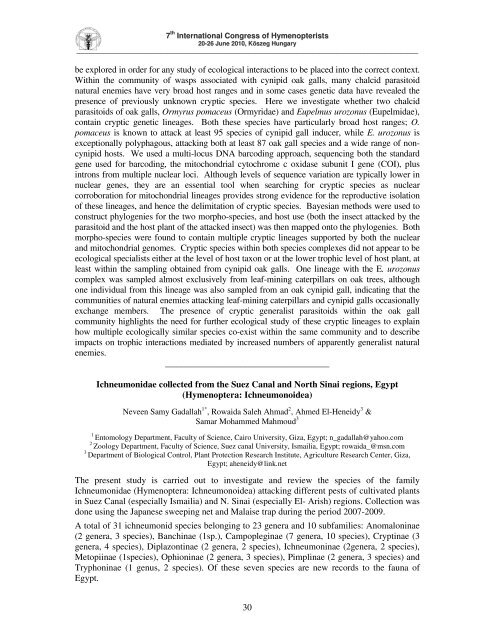Seventh International Congress of Hymenopterists
Seventh International Congress of Hymenopterists
Seventh International Congress of Hymenopterists
You also want an ePaper? Increase the reach of your titles
YUMPU automatically turns print PDFs into web optimized ePapers that Google loves.
7 th <strong>International</strong> <strong>Congress</strong> <strong>of</strong> <strong>Hymenopterists</strong><br />
20-26 June 2010, Kszeg Hungary<br />
_____________________________________________________________________________________________________<br />
be explored in order for any study <strong>of</strong> ecological interactions to be placed into the correct context.<br />
Within the community <strong>of</strong> wasps associated with cynipid oak galls, many chalcid parasitoid<br />
natural enemies have very broad host ranges and in some cases genetic data have revealed the<br />
presence <strong>of</strong> previously unknown cryptic species. Here we investigate whether two chalcid<br />
parasitoids <strong>of</strong> oak galls, Ormyrus pomaceus (Ormyridae) and Eupelmus urozonus (Eupelmidae),<br />
contain cryptic genetic lineages. Both these species have particularly broad host ranges; O.<br />
pomaceus is known to attack at least 95 species <strong>of</strong> cynipid gall inducer, while E. urozonus is<br />
exceptionally polyphagous, attacking both at least 87 oak gall species and a wide range <strong>of</strong> noncynipid<br />
hosts. We used a multi-locus DNA barcoding approach, sequencing both the standard<br />
gene used for barcoding, the mitochondrial cytochrome c oxidase subunit I gene (COI), plus<br />
introns from multiple nuclear loci. Although levels <strong>of</strong> sequence variation are typically lower in<br />
nuclear genes, they are an essential tool when searching for cryptic species as nuclear<br />
corroboration for mitochondrial lineages provides strong evidence for the reproductive isolation<br />
<strong>of</strong> these lineages, and hence the delimitation <strong>of</strong> cryptic species. Bayesian methods were used to<br />
construct phylogenies for the two morpho-species, and host use (both the insect attacked by the<br />
parasitoid and the host plant <strong>of</strong> the attacked insect) was then mapped onto the phylogenies. Both<br />
morpho-species were found to contain multiple cryptic lineages supported by both the nuclear<br />
and mitochondrial genomes. Cryptic species within both species complexes did not appear to be<br />
ecological specialists either at the level <strong>of</strong> host taxon or at the lower trophic level <strong>of</strong> host plant, at<br />
least within the sampling obtained from cynipid oak galls. One lineage with the E. urozonus<br />
complex was sampled almost exclusively from leaf-mining caterpillars on oak trees, although<br />
one individual from this lineage was also sampled from an oak cynipid gall, indicating that the<br />
communities <strong>of</strong> natural enemies attacking leaf-mining caterpillars and cynipid galls occasionally<br />
exchange members. The presence <strong>of</strong> cryptic generalist parasitoids within the oak gall<br />
community highlights the need for further ecological study <strong>of</strong> these cryptic lineages to explain<br />
how multiple ecologically similar species co-exist within the same community and to describe<br />
impacts on trophic interactions mediated by increased numbers <strong>of</strong> apparently generalist natural<br />
enemies.<br />
____________________________________<br />
Ichneumonidae collected from the Suez Canal and North Sinai regions, Egypt<br />
(Hymenoptera: Ichneumonoidea)<br />
Neveen Samy Gadallah 1* , Rowaida Saleh Ahmad 2 , Ahmed El-Heneidy 3 &<br />
Samar Mohammed Mahmoud 3<br />
1 Entomology Department, Faculty <strong>of</strong> Science, Cairo University, Giza, Egypt; n_gadallah@yahoo.com<br />
2 Zoology Department, Faculty <strong>of</strong> Science, Suez canal University, Ismailia, Egypt; rowaida_@msn.com<br />
3 Department <strong>of</strong> Biological Control, Plant Protection Research Institute, Agriculture Research Center, Giza,<br />
Egypt; aheneidy@link.net<br />
The present study is carried out to investigate and review the species <strong>of</strong> the family<br />
Ichneumonidae (Hymenoptera: Ichneumonoidea) attacking different pests <strong>of</strong> cultivated plants<br />
in Suez Canal (especially Ismailia) and N. Sinai (especially El- Arish) regions. Collection was<br />
done using the Japanese sweeping net and Malaise trap during the period 2007-2009.<br />
A total <strong>of</strong> 31 ichneumonid species belonging to 23 genera and 10 subfamilies: Anomaloninae<br />
(2 genera, 3 species), Banchinae (1sp.), Campopleginae (7 genera, 10 species), Cryptinae (3<br />
genera, 4 species), Diplazontinae (2 genera, 2 species), Ichneumoninae (2genera, 2 species),<br />
Metopiinae (1species), Ophioninae (2 genera, 3 species), Pimplinae (2 genera, 3 species) and<br />
Tryphoninae (1 genus, 2 species). Of these seven species are new records to the fauna <strong>of</strong><br />
Egypt.<br />
30


